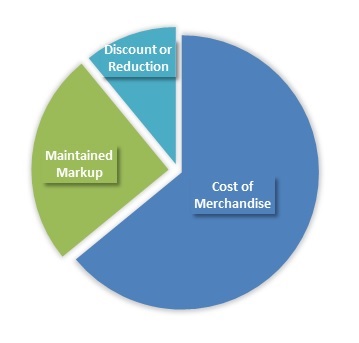- Business Concepts ›
- Marketing and Strategy ›
- Maintained Markup
Maintained Markup
Definition, Importance & Example
This article covers meaning & overview of Maintained Markup from marketing perspective.
What is meant by Maintained Markup?
Maintained markup is a price adjustment where the price is reduced to above the cost to a new price. Maintained markup is done when the product does not sell and keeps lying in the store for some time. When a product arrives at the store, a price tag is attached which is pre-determined. This is the initial markup price above the cost.
Initial markup = Original price – Cost / Original price
Maintained Markup= Actual Retail Price – Cost / Actual Retail Price
The maintained markup is hence the actual selling price minus the cost.
Importance of Maintained Markup
Maintained markup price is one of the most important retail pricing strategies as a part of markup pricing. In this, markup is the percentage increase or decrease of price. The initial markup is done after considering the cost of goods sold, the operating expenses and the desired profit. But the maintained mark up is done with the purpose of clearing up the non-selling products.
It is important for the retailers to know the demand for the product and accordingly set the price. The maintained mark up is lower than the initial markup and hence there is a reduction in profit. The initial price must be fixed such that there is considerable profit even at the maintained markup price.

Read More
Advantages of Maintained Markup
Some advantages of Maintained markup are:
1. Promotes sale of slow-moving products Some of the common examples of products which may be lying on the shop floor without moving are wholesale apparel and footwear. These may be termed as slow-moving products. When the retailer drops the price of the product from the initial markup price to the maintained markup price, the product is likely to move faster through the system. Hence, for non-selling products, this is the best way to promote sale.
2. Ensures a profit margin: The maintained markup price is always above the cost, thus ensuring a fair return. The profit margin may be reduced than initial but still there’s considerable profit on the product.
Disadvantages of Maintained Markup
Reduced Profit: Had the product been sold at the initial markup price, the profit would have been fairly high that what it is at the maintained markup price. This is not good for businesses with huge debts because the payable amount depends on the earnings which takes a hit.
Example of Maintained Markup
Suppose the price of a shirt is $100. The total cost is $50.
Initial Markup= Original price-cost/original price = 100-50/100 = 0.5 or 50%
The retailer changes the price to $70
Maintained markup = Actual SP- Cost/Actual SP = 70-50/70 = 0.286 or 29%
Hence, this concludes the definition of Maintained Markup along with its overview.
This article has been researched & authored by the Business Concepts Team which comprises of MBA students, management professionals, and industry experts. It has been reviewed & published by the MBA Skool Team. The content on MBA Skool has been created for educational & academic purpose only.
Browse the definition and meaning of more similar terms. The Management Dictionary covers over 1800 business concepts from 5 categories.
Continue Reading:
What is MBA Skool?About Us
MBA Skool is a Knowledge Resource for Management Students, Aspirants & Professionals.
Business Courses
Quizzes & Skills
Quizzes test your expertise in business and Skill tests evaluate your management traits
Related Content
All Business Sections
Write for Us